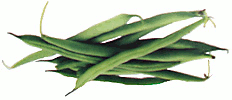Green beans nutrition facts
Tender, flexible green beans
are delight of vegetarian lovers for their
wholesome nutritional qualities. They are unripe or immature pods
obtained from
the bean plant belonging to common fabaceae
family and known scientifically as Phaseolus
vulgaris.
Broadly, tender beans are
classified depending on their growth habits
as "bush beans" which stand erect without support and "Pole Beans"
that need climb supports. The other varieties
of unripe fruits of beans family include Shell beans, Pinto or mottled
beans, White beans, Red or kidney beans, Black beans, Pink beans and
Yellow wax beans. All most all the varieties are available year around
across the world.
Fava or broad beans (Vicia faba) are large,
flattened light green pods usually eaten shelled for their delicious
beans. Lima beans (Phaseolus lunatus) are large, plump, pale green pods
with kidney shaped seeds.
Health benefits of Green beans
-
Fresh green beans are very
low in calories (31 kcal per 100 g of raw beans) and contain no
saturated fat; but are very good source of vitamins, minerals, and
plant
derived micronutrients.
-
They are very rich source
of dietary fiber (9%
per100g RDA)
which acts as bulk laxative that helps to protect the mucous membrane
of the
colon by decreasing its exposure time to toxic substances as well as by
binding to cancer causing chemicals in the colon. Dietary fiber has
also been shown to reduce blood cholesterol levels by decreasing
re-absorption of cholesterol binding bile acids in the colon.
-
Green beans contain
excellent levels of vitamin
A, and many health promoting flavonoid poly phenolic antioxidants such
as lutein, zeaxanthin and ß-carotene in good amounts. These
compounds
help act as protective scavengers against oxygen-derived free radicals
and reactive oxygen species (ROS) that play a role in aging and various
disease process.
-
Zea-xanthin,
an important dietary carotenoid in
the beans, selectively absorbed into the retinal macula lutea in the
eyes where it thought to provide antioxidant and protective
UV light filtering
functions. It is, therefore, green beans offer some protection in
preventing age related
macular disease (ARMD) in the elderly.
-
They also contain good
amounts of
-
Fresh snap beans are good
source of folates.
100 g fresh beans provide 37 µg or 9% of folates. Folate along with
vitamin B-12 is one of the essential components of DNA synthesis and
cell division. Good folate diet when given during
preconception periods and during pregnancy helps
prevent from neural-tube defects in the offspring.
-
Fresh snap beans are good
source of folates.
100 g fresh beans provide 37 µg or 9% of folates. Folate along with
vitamin B-12 is one of the essential components of DNA synthesis and
cell division. Good folate diet when given during
preconception periods and during pregnancy helps
prevent from neural-tube defects in the offspring.
-
In addition, beans contain healthy
amounts of minerals like
iron,
calcium, magnesium, manganese, and potassium, which are very
essential for body metabolism. Manganese is a co-factor for the anti
oxidant enzyme superoxide
dismutase, which is a very powerful free radical scavenger.
Potassium is an important component of cell and body fluids that helps
controlling heart rate and blood pressure.
| Principle | Nutrient Value | Percentage of RDA |
|---|---|---|
| Energy | 31 Kcal | 1.5% |
| Carbohydrates | 7.13 g | 5.5% |
| Protein | 1.82 g | 3% |
| Total Fat | 0.34 g | 1% |
| Cholesterol | 0 mg | 0% |
| Dietary Fiber | 3.4 g | 9% |
| Vitamins | ||
| Folates | 37 µg | 9% |
| Niacin | 0.752 mg | 5% |
| Pantothenic acid | 0.094 mg | 2% |
| Pyridoxine | 0.074 mg | 5.5% |
| Riboflavin | 0.105 mg | 8% |
| Thiamin | 0.084 mg | 7% |
| Vitamin A | 690 IU | 23% |
| Vitamin C | 16.3 mg | 27% |
| Vitamin K | 14.4 µg | 12% |
| Electrolytes | ||
| Sodium | 6 mg | 0.4% |
| Potassium | 209 mg | 5.5% |
| Minerals | ||
| Calcium | 37 mg | 3.7% |
| Iron | 1.04 mg | 13% |
| Magnesium | 25 mg | 6% |
| Manganese | 0.214mg | 9% |
| Phosphorus | 38 mg | 6% |
| Zinc | 0.24 mg | 2% |
| Phyto-nutrients | ||
| Carotene-ß | 379 µg | -- |
| Carotene-α | 69 µg | -- |
| Lutein-zeaxanthin | 640 µg | -- |
Selection and storage

Raw fresh
green beans, also
called as snap beans or
French beans, should be tender, long,
stiff, but flexible and give snap sound when broken. Buy them from
organic stores for their rich “beany” flavor.
Avoid limp or
overly matured beans with tough
skin.
To store,
place them in a perforated plastic bag
and keep inside the refrigerator set at high relative humidity. They
keep well for up to a week.
Preparation and serving methods
Wash raw beans in cold water. Just before using, remove the
strings and trim the ends.
Here are some
serving tips:
-
Green beans are most favored vegetable items
in
stir-fry, stews, grilled-salads, Steamed along with carrots,
cauliflower,
peas, tomato...etc.
-
They mix well with cheese, nuts, mushroom,
seafood, meat etc.
-
In Asian region, they are used in curries, soups, stir-fry with rice (rice pilaf) etc.
Safety profile
Green beans
contain oxalic
acid, a naturally occurring substance found
in some vegetables, which, may crystallize as oxalate stones in the
urinary tract in some people. It is, therefore, people with known
oxalate urinary tract stones are advised against eating vegetables
belong to brassica and fabaceae family. Adequate intake of water is
therefore advised to maintain normal urine output to minimize the stone
risk.(Medical
disclaimer).
No comments:
Post a Comment